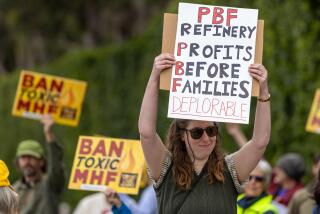Torrance Doubts Mobil Study, Hires Consultant to Review It
- Share via
Some Torrance officials have found fault with a Mobil report that downplays the risk of acutely toxic hydrofluoric acid at the oil company’s Torrance refinery, and the City Council has unanimously decided to hire a consultant to scrutinize the report.
The inch-thick risk-assessment study, released last Thursday by Mobil, concluded that the risk posed by continued use of the chemical at the Torrance refinery is 1.21 fatalities per 100 years.
“It seems to me this is not the significant report I expected a year ago,” Mayor Katy Geissert said in an interview after Tuesday’s vote to hire the consultant, the NUS Corp. of San Diego, which will be paid $83,250 to review the Mobil study.
Torrance Fire Chief R. Scott Adams complained that the report did not say what would happen in the event of sabotage or a major natural disaster such as an earthquake. He added that the report’s recommendations for safety improvements include no deadlines for completion.
“This is a grossly inadequate report,” said Councilman Dan Walker, Mobil’s most vociferous critic on the council.
Accident Data Withheld
He added that it is “ludicrous” that Mobil did not release data on more than 700 accident scenarios that its consultants studied to produce the report. All of the scenarios involved releases of hydrofluoric acid, which can produce a ground-hugging vapor cloud that, in sufficient quantities, can be deadly to exposed people five miles downwind.
NUS, a 26-year-old company specializing in risk assessment and management consulting, is expected to take 12 weeks to review the study and identify any errors and questions left unanswered. When NUS completes its analysis, Mobil will have 60 days to correct the errors and resubmit the study.
If NUS finds no flaws, Mobil has a year to implement safety recommendations put forth in the study. Mobil officials have said the company will follow the report’s recommendations.
In analyzing the study, NUS will seek the assistance of Ronald Koopman, an expert on releases and dispersion of hydrofluoric acid and efforts to mitigate the effects. Koopman, leader of a group of scientists studying heavy and toxic gasses at Lawrence Livermore Laboratory in Northern California, directed oil industry-sponsored tests on hydrofluoric acid at Frenchman Flats in Nevada in 1986 and 1988.
Study Cost $275,000
The risk study, which cost Mobil $275,000, was requested a year ago by the Torrance Fire Department under provisions of a state law governing acutely toxic chemicals. Written by Technica Inc. and Stone & Webster Environmental Services, the report contains recommendations for improving safety systems to minimize the risk of an accident involving hydrofluoric acid.
Recommended improvements include installation by 1991 of a $6-million acid evacuation system that would drain the lethal chemical to a storage tank in an emergency. Other improvements will include better training, safety equipment and alarm systems.
Much of the debate about the report centers on material that Mobil has refused to release, including details of the 700 accident scenarios that its consultants studied and maps showing hypothetical vapor plumes over residential areas.
Mobil refinery manager Wyman D. Robb said last week that Mobil was not going to release the plume maps because the oil company did not want to scare people.
But Walker said: “For them to keep everybody in the dark about a (potential) problem is wrong.”
Geissert added that the scenarios should have been included in the report, and agreed with Walker that residents should be told what potential disasters can result from the release of hydrofluoric acid.
“People are even more afraid of the unknown than of what is known,” she said. “I think that people can deal” with the scenarios.
Adams said state law does not require Mobil to include the scenarios in the study. He said the Fire Department has access to the scenarios but that he will wait until NUS completes its analysis before deciding whether to release the information to the public.
Mobil spokesman Jim Carbonetti said Wednesday that the oil company will try to work with the Fire Department to provide any information that it requests.
More to Read
Sign up for Essential California
The most important California stories and recommendations in your inbox every morning.
You may occasionally receive promotional content from the Los Angeles Times.














